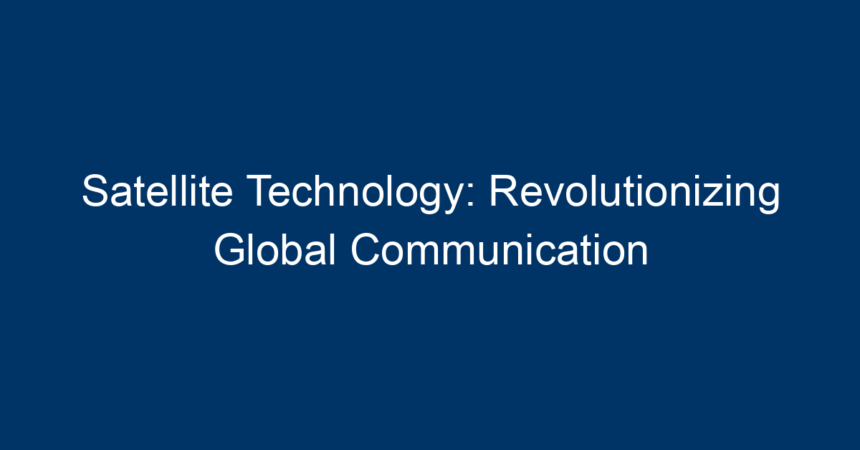In the age of digital transformation, satellite technology plays a pivotal role in reshaping global communication. It enables seamless connectivity across vast distances, empowering businesses and individuals alike. From providing critical broadcast services to ensuring remote areas gain internet access, satellite technology stands as an essential bridge in our increasingly interconnected world. In this article, we will delve into the various facets of satellite technology, its applications, advancements, and the future it promises in global communication.
Understanding Satellite Technology
What is Satellite Technology?
At its core, satellite technology involves the use of artificial satellites deployed in orbit around the Earth to facilitate communication, navigation, monitoring, and data collection. These satellites operate primarily through three types of orbits:
-
Geostationary Orbits (GEO): Satellites in GEO remain stationary relative to the Earth’s surface. They are commonly used for telecommunication, broadcasting, and weather monitoring.
-
Medium Earth Orbits (MEO): Often used for navigation systems like GPS, MEO satellites provide essential positioning services across the globe.
- Low Earth Orbits (LEO): These satellites, orbiting at altitudes between 160 to 2,000 kilometers, are critical for internet services, especially in remote areas, due to their low latency.
The Evolution of Satellite Technology
The journey of satellite technology began with the launch of Sputnik 1 by the USSR in 1957. Over the decades, technological advancements have led to increased efficiency, improved communication capabilities, and cost-effective solutions. The dawn of commercial satellite services in the 1980s further propelled the growth of this industry, offering everything from television broadcasts to internet connectivity. Today, thousands of satellites populate our skies, powering a vast array of services.
The Impact of Satellite Technology on Communication
Enabling Global Connectivity
Satellite technology has been a game-changer in bridging the communication gap between urban and rural areas. High-speed internet access remains a challenge in many parts of the world. Traditional cable and fiber-optic solutions often overlook remote locations. However, satellite internet services, such as those provided by companies like Starlink, have started to change this narrative by offering connectivity to even the most isolated regions.
Broadcast Services and Satellite Television
The advent of satellite television has revolutionized the way we consume media. Channels such as DIRECTV and Dish Network use satellites to broadcast signals directly to homes, allowing viewers to access a diverse range of content without reliance on traditional cable systems. This technology not only enhances engagement but also fosters cultural exchange by delivering international programming.
Weather Forecasting and Disaster Management
Another crucial application of satellite technology is in weather forecasting and disaster management. Satellites equipped with advanced sensors monitor atmospheric conditions and provide data critical for accurate weather predictions. Emergency services utilize this information to respond effectively to disasters, ensuring timely evacuations and resource allocation during natural calamities.
Advancements in Satellite Technology
Innovative Satellite Designs
Modern satellite technology has witnessed the emergence of innovative designs that enhance functionality and longevity. The integration of artificial intelligence (AI) into satellite operations allows for predictive maintenance and real-time data analysis, ensuring optimized performance. CubeSats—small, cost-effective satellites—have also gained popularity, providing flexibility for new ventures and research initiatives.
Miniaturization and Enhanced Capabilities
The miniaturization of satellite components has expanded the potential for deploying satellites into orbit. Smaller satellites are less costly to launch and can be packed in large numbers aboard a single rocket, creating the ability to establish large satellite constellations. These constellations, particularly in LEO, facilitate low-latency services essential for communication and IoT applications.
Advanced Ground Stations
Modern ground stations equipped with sophisticated technology can handle multiple satellites simultaneously, enabling efficient data transmission and management. The advent of software-defined radios (SDRs) has also improved flexibility, allowing ground stations to adapt to various satellite signals and formats seamlessly.
Challenges in Satellite Technology
Space Debris and Sustainability
As the number of satellites in orbit increases, the issue of space debris poses significant challenges. Decommissioned satellites and fragments from collisions threaten operational satellites, potentially leading to dangerous scenarios. Addressing this requires enhanced regulatory frameworks and innovative solutions focused on sustainability.
Regulatory Hurdles
Navigating the regulatory landscape remains a challenge for companies in the satellite technology sector. Different countries have varying rules on satellite launches and operation, and obtaining permits can be a lengthy process. Streamlining regulations could promote innovation and ease in the deployment of new technologies.
The Future of Satellite Technology in Global Communication
The Rise of Satellite Internet
As more companies invest in deploying satellite constellations, the future of internet access promises to change dramatically. Starlink, OneWeb, and other initiatives are working tirelessly to establish high-speed internet access worldwide. This move will not only aid underserved areas but will also support emerging markets and industries.
Integration with 5G Networks
A significant advancement on the horizon is the integration of satellite technology with 5G networks. This collaboration could enhance connectivity by providing backhaul services to remote regions, thereby enabling the full potential of 5G technology where traditional infrastructure fall short.
Enhanced Data Collection and Global Monitoring
With the flexibility and capabilities of modern satellite technology, there will be expanded applications in climate monitoring, urban planning, and agriculture. Enhanced data collection from satellites will provide valuable insights that can be used for better decision-making in disaster response and environmental conservation.
Conclusion: Embracing the Future of Satellite Technology
In conclusion, satellite technology stands at the forefront of revolutionizing global communication. With the promise of improved connectivity, enhanced services, and groundbreaking innovations, the future of humanity is undeniably intertwined with satellites orbiting our planet. As we move forward, embracing advancements in satellite technology will be crucial in ensuring the benefits of global communication reach every corner of the globe.
Actionable Insights
-
Stay Informed: Follow advancements in satellite technology to understand its impact on communication and internet services.
-
Explore Opportunities: Consider how satellite solutions can benefit your business or community, especially in remote areas lacking internet access.
- Support Sustainability: Advocate for and engage in discussions about sustainable practices in the satellite industry to protect our orbital environment.
By leveraging the revolutionary capabilities of satellite technology, we step closer to a truly interconnected world, where communication is no longer hindered by distance.




